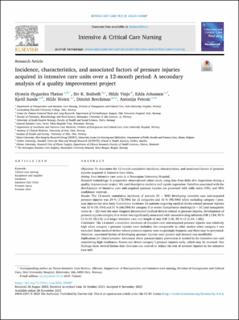| dc.contributor.author | Flæten, Øystein Øygarden | |
| dc.contributor.author | Stafseth, Siv Anna Ulla-Britt Karlsson | |
| dc.contributor.author | Vinje, Hilde | |
| dc.contributor.author | Johansen, Edda Aslaug | |
| dc.contributor.author | Sunde, Kjetil | |
| dc.contributor.author | Wøien, Hilde | |
| dc.contributor.author | Dimitri, Beeckman | |
| dc.contributor.author | Petosic, Antonija | |
| dc.date.accessioned | 2024-02-12T10:40:03Z | |
| dc.date.available | 2024-02-12T10:40:03Z | |
| dc.date.created | 2023-11-29T17:41:45Z | |
| dc.date.issued | 2023 | |
| dc.identifier.citation | Intensive & Critical Care Nursing. 2023, 81 1-7. | |
| dc.identifier.issn | 0964-3397 | |
| dc.identifier.uri | https://hdl.handle.net/11250/3116846 | |
| dc.description.abstract | Objectives: To determine the 12-month cumulative incidence, characteristics, and associated factors of pressure injuries acquired in Intensive Care Units. Setting: Four intensive care units in a Norwegian University Hospital. Research methodology: A prospective observational cohort study using data from daily skin inspections during a quality improvement project. We used descriptive statistics and logistic regression. Variables associated with the development of intensive care unit-acquired pressure injuries are presented with odds ratios (OR), and 95% confidence intervals. Results: The 12-month cumulative incidence of patients (N = 594) developing intensive care unit-acquired pressure injuries was 29 % (172/594) for all categories and 16 % (95/594) when excluding category I pres- sure injuries (no skin loss). Cumulative incidence for patients acquiring medical device-related pressure injuries was 15 % (91/594) and 11 % (64/594) for category II or worse. Compression stockings (n = 51) and nasogastric tubes (n = 22) were the most frequent documented medical devices related to pressure injuries. Development of pressure injuries category II or worse was significantly associated with vasoactive drug infusions (OR 11.84, 95 % CI [1.59; 88.13]) and longer intensive care unit length of stay (OR 1.06, 95 % CI [1.04; 1.08]). Conclusion: The 12-month cumulative incidence of intensive care unit-acquired pressure injuries was relatively high when category I pressure injuries were included, but comparable to other studies when category I was excluded. Some medical device-related pressure injuries were surprisingly frequent, and these may be prevented. However, associated factors of developing pressure injuries were present and deemed non-modifiable. Implications for clinical practice: Awareness about pressure injury prevention is needed in the intensive care unit considering high incidences. Nurses can detect category I pressure injuries early, which may be reversed. Our findings show several factors that clinicians can control to reduce the risk of pressure injuries in the intensive care unit. | |
| dc.description.abstract | Incidence, characteristics, and associated factors of pressure injuries acquired in intensive care units over a 12-month period: A secondary analysis of a quality improvement project | |
| dc.language.iso | eng | |
| dc.title | Incidence, characteristics, and associated factors of pressure injuries acquired in intensive care units over a 12-month period: A secondary analysis of a quality improvement project | |
| dc.title.alternative | Incidence, characteristics, and associated factors of pressure injuries acquired in intensive care units over a 12-month period: A secondary analysis of a quality improvement project | |
| dc.type | Peer reviewed | |
| dc.type | Journal article | |
| dc.description.version | publishedVersion | |
| dc.source.pagenumber | 1-7 | |
| dc.source.volume | 81 | |
| dc.source.journal | Intensive & Critical Care Nursing | |
| dc.identifier.doi | 10.1016/j.iccn.2023.103587 | |
| dc.identifier.cristin | 2205624 | |
| cristin.ispublished | true | |
| cristin.fulltext | original | |
| cristin.qualitycode | 1 | |
